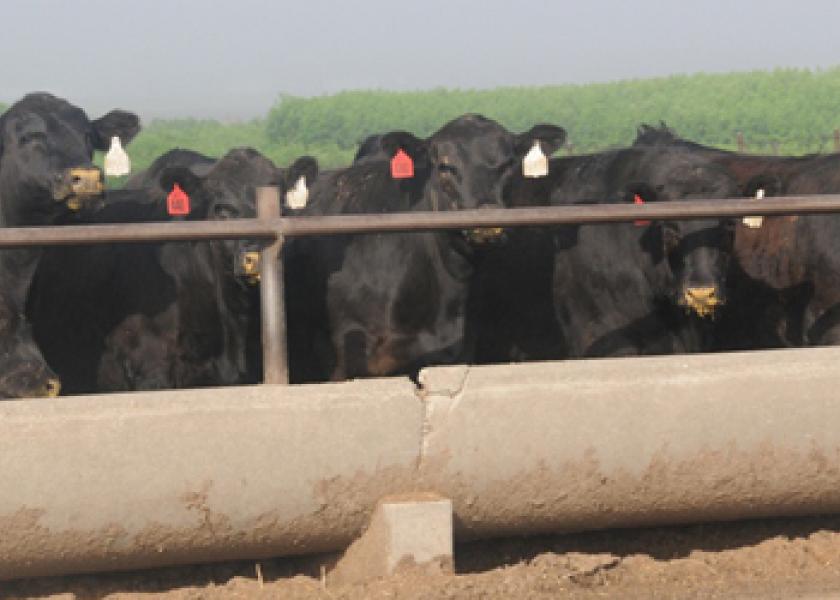Did High Heat And Humidity Really Cause Cattle Deaths In Kansas? The Latest Look at Potential Losses

Drought-plagued western Kansas recently saw rain. While the moisture was welcomed, it also coupled high humidity with high heat this week. As feedyards battled through the intense conditions to keep their cattle safe, the heat and humidity proved devastating, with estimates now pointing to feedlots seeing losses of 100 to 500 head per day.
An unconfirmed video of dead black-hided cattle made its rounds on social media this week. The rare scenario is something feedlot operators couldn’t avoid. Dr. Dan Thomson, a bovine vet who specializes in animal health welfare, recently spoke to Farm Journal’s Michelle Rook.
“If we have a rain event that increases the humidity in the environment, through mud and different things like that, followed by extreme temperatures with a decrease in wind, we can see these thermal heat indexes rise to where cattle accumulate heat,” Thomson says.
He says the scenario is similar to the impact of a natural disaster. While feedlots did everything possible to prepare and provide cattle relief, the climate conditions meant the cattle didn't have a chance to cool down, and in some cases, the internal temperature rose too much, which caused the rare losses.
“During these bouts of extreme heat, the cattle can't dissipate the heat at night because there's not night cooling," Thomson says. “And so this perfect storm, it's no different than a tornado hitting a cattle feeding facility or a derecho. We have these natural disasters.”
Estimated Losses Still in Question
While there’s no way of knowing just how many cattle have died from the heat this week, Reuters quoted the Kansas Department of Health and Environment saying at least 2,000 head of cattle had been lost. One Drovers source says it’s very possible 5,000 cattle may have succumbed to the heat, but the talk of 10,000 head is likely an exaggeration of reality.
With herd culling is already taking place due to the drought this year, Mark Gold of StoneX Group says it will have an impact on the supply of cattle in the U.S.
“The rumors are that we're losing 100 to 500 head per feedlot out here,” says Gold. “That's a lot of cattle.
Losses Could Have Been Worse
No matter what the final total ends up being, those losses are difficult for feedyard operators and employees who Thomson says made a relentless effort to get the cattle water and comfort through bedding in order to help the cattle cool off.
“It's something if our people on the ground wouldn't have been doing the job that they're doing, there would have been so much more death loss,” he says.
High Heat Expected to Stick Around
The record-breaking heat across the South and Midwest is something that may continue to be a factor in the months ahead. The extreme weather, including hail and flooding, can all be attributed to a ridge of high pressure parked over the country.
USDA meteorologist Brad Rippey says while the ridge of high pressure is parked over the country, it has been shape shifting the past few days.
“This year, 2022, it does appear that we have a rather intense ridge of high pressure,” says Rippey.
Rippey says a ridge of high pressure is an annual occurrence, conditions just vary based on where the ridge is located, and how intense it is.
“We saw it become established over the desert southwest, it's made a run across the great plains now more recently into the Midwest, the mid-South, and even the Southeast with early triple digit heat, that in fact is maybe a bit of a warning sign ,” Rippey explains .
Rippey says as the ridge shape shifts, the outer edge creates what's called a "ring of fire." That ring can then cause severe storms, including the hail and flooding this week. He expects the ridge to stick around, but there's no way of knowing exactly where the ridge remains parked, but he does expect hot and dry conditions in the souther plains.
Parts of Texas, Oklahoma and Kansas have seen recent rains. While it is prompting pasture conditions to slightly improve, Derrell Peel, Oklahoma State University livestock specialist, says damage from the drought has already been done.
"I think we're looking at a record level of net cow culling up around 13% and probably a 3% to 4% decrease in the beef cow herd," says Peel. "Even if the drought conditions changed dramatically from this point on, it's almost too late for us to really recover from the loss and forage and the amount of cows we've already culled this year."







